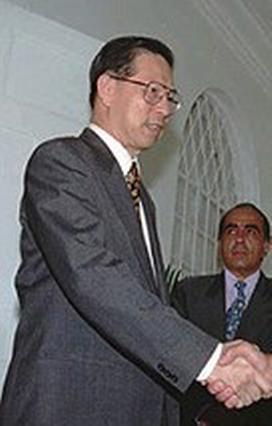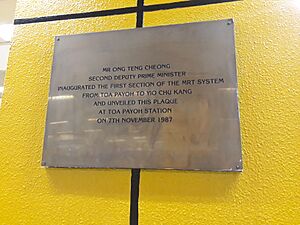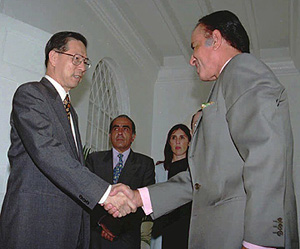Ong Teng Cheong facts for kids
Quick facts for kids
Ong Teng Cheong
|
|
|---|---|
|
王鼎昌
|
|

Ong in 1997
|
|
| 5th President of Singapore | |
| In office 1 September 1993 – 1 September 1999 |
|
| Prime Minister | Goh Chok Tong |
| Preceded by | Wee Kim Wee |
| Succeeded by | S. R. Nathan |
| 3rd Deputy Prime Minister of Singapore | |
| In office 2 January 1985 – 16 August 1993 Serving with Goh Chok Tong (1985–1990)
and Lee Hsien Loong (1990–2004) |
|
| Prime Minister | Lee Kuan Yew Goh Chok Tong |
| Preceded by | Goh Keng Swee S. Rajaratnam |
| Succeeded by | Lee Hsien Loong Tony Tan |
| 2nd Chairman of the People's Action Party | |
| In office 5 January 1981 – 16 August 1993 |
|
| Preceded by | Toh Chin Chye |
| Succeeded by | Tony Tan |
| Secretary-General of the National Trades Union Congress | |
| In office May 1983 – 1 September 1993 |
|
| Deputy | Goh Chee Wee |
| Preceded by | Lim Chee Onn |
| Succeeded by | Lim Boon Heng |
| Minister for Labour | |
| In office 5 January 1981 – 9 May 1983 |
|
| Prime Minister | Lee Kuan Yew |
| Preceded by | Ong Pang Boon |
| Succeeded by | E. W. Barker |
| Minister for Communications | |
| In office 1 July 1977 – 9 May 1983 |
|
| Prime Minister | Lee Kuan Yew |
| Preceded by | Lim Kim San |
| Succeeded by | Ong Pang Boon |
| Member of the Singapore Parliament for Toa Payoh GRC (Kim Keat) |
|
| In office 21 August 1991 – August 1993 |
|
| Preceded by | Constituency established |
| Succeeded by | Constituency abolished |
| Member of the Singapore Parliament for Kim Keat SMC |
|
| In office 2 September 1972 – 14 August 1991 |
|
| Preceded by | Constituency established |
| Succeeded by | Constituency abolished |
| Personal details | |
| Born |
Ong Teng Cheong
22 January 1936 Singapore, Straits Settlements |
| Died | 8 February 2002 (aged 66) Tanglin, Singapore |
| Cause of death | Lymphoma |
| Resting place | Mount Vernon Columbarium |
| Political party | Independent |
| Other political affiliations |
People's Action Party (1972–1993) |
| Spouse |
Ling Siew May
(m. 1963; died 1999) |
| Children | 2 |
| Alma mater | University of Adelaide (BArch) University of Liverpool (MCD) |
| Occupation |
|
Ong Teng Cheong GCMG (born 22 January 1936 – died 8 February 2002) was a very important person in Singapore. He was an architect and a leader for workers. He served as the fifth President of Singapore from 1993 to 1999.
He was the first president to be chosen directly by the people of Singapore through an election. This happened in the 1993 Singaporean presidential election. Before becoming president, he was a member of the People's Action Party (PAP). He was the Chairman of the PAP from 1981 to 1993.
Ong Teng Cheong was also a Member of Parliament (MP) for different areas in Singapore. He held several important jobs in the government. These included Minister for Communications (1978–1981) and Minister for Labour (1981–1983). He also served as Deputy Prime Minister from 1985 to 1993.
He was well-known for strongly supporting the building of Singapore's huge train network. This system is called the Mass Rapid Transit (MRT). It was the biggest building project in Singapore's history.
In 1993, Ong Teng Cheong left his political party and government jobs. He wanted to run for president. He won the election with 58.7% of the votes. People sometimes called him the "People's President." He became president on 1 September 1993. He decided not to run for a second term in 1999. This was partly because his wife passed away. S. R. Nathan took over as president after him. Ong Teng Cheong died peacefully in his sleep on 8 February 2002, at the age of 66. He had lymphoma.
Contents
Early Life and Education
Ong Teng Cheong was born in Singapore on 22 January 1936. He was the second of five children in his family. His father believed that learning Chinese was important for business. So, all his children went to Chinese-language schools.
Ong graduated with high marks from The Chinese High School in 1955. After studying in Chinese, he felt there were not many chances for him to study at the University of Malaya. This was because the university taught in English.
In 1956, Ong went to study abroad with help from his father's friends. He studied architecture at the University of Adelaide in Australia. His childhood sweetheart and future wife, Ling Siew May, also studied there. They had met at a Christmas party when they were in secondary school.
In 1965, Ong received a special scholarship called the Colombo Plan scholarship. This allowed him to study for a master's degree in urban planning at the University of Liverpool. He finished his studies in 1967.
Career Journey
After finishing his studies, Ong worked as an architect in Adelaide, Australia. He married Ling Siew May in 1963. They sometimes recited Chinese poems they learned when they were younger.
In 1967, Ong joined the Ministry of National Development (MND). He worked there as a town planner. After four years, he left the government in 1971. He then started his own architecture firm with his wife. It was called Ong & Ong Architects & Town Planners.
Political Journey
Ong Teng Cheong's political career lasted for 21 years. He was a Member of Parliament (MP) and a Cabinet minister. He also served as Deputy Prime Minister. Later, he became the first elected President of Singapore in 1993.
His political journey began when he helped with community activities in Seletar. This led him to meet Prime Minister Lee Kuan Yew. The People's Action Party (PAP) then chose him to run as a candidate. He ran for the Kim Keat SMC in the 1972 Singaporean general election.
Building the MRT

Ong Teng Cheong received his first government job three years later. He became the Senior Minister of State for Communications. At that time, he was famous for pushing for a large train network in Singapore. This network is now known as the Mass Rapid Transit (MRT). It was the biggest construction project in Singapore's history.
As Minister for Communications, Ong continued to strongly support the MRT system. He often disagreed with other politicians who were against the idea. He later became the Second Deputy Prime Minister in 1985.
The idea for the MRT came from a study in 1967. It said Singapore would need a train system by 1992. However, some government ministers were against it. They worried about the cost and whether there would be enough jobs in construction.
There was a big discussion about whether a bus-only system would be cheaper. But Ong believed that only buses would not be enough. Singapore is a small country, and buses would compete for road space. Ong was trained as an architect and town planner. Because of his strong efforts, he became the main person behind building the MRT. Ong and others who supported the train system eventually won the argument. The MRT project was approved in May 1982.
Leading the NTUC
Changes in Union Leadership
In 1983, Ong Teng Cheong took over from Lim Chee Onn as the Secretary-General of the National Trades Union Congress (NTUC). The NTUC is a group of trade unions that works closely with the PAP government. They have a special partnership.
However, by the 1980s, the relationship between the unions and the government became a bit difficult. Some older union leaders felt left out of important decisions. Lee Kuan Yew felt that Lim Chee Onn was not doing well in connecting the top leaders with the regular union members.
Ong Teng Cheong was chosen to lead the NTUC. He was also the Minister for Labour and Chairman of the PAP. Many saw him as a possible future leader of Singapore.
Working with Unions
Ong worked hard to fix the relationship between the unions and the government. He listened more to the union members. He also made sure that regular union leaders were more involved in the NTUC's decisions.
Ong was a very active union leader. He worked strongly for the rights of workers. He pushed the limits of what the government would allow for union activities. In return, the unions agreed to work with the government's plans for workers.
In January 1986, Ong approved a strike in the shipping industry. This was the first strike in Singapore in about ten years. He believed it was needed because "management were taking advantage of the workers." He did not tell the Cabinet beforehand. He was afraid they would stop him. Ong later said that some ministers were angry with him. But he felt the strike was a success. It only lasted two days, and all the problems were solved.
Ong also organized a large protest of 4,000 people. This protest was at the United States Embassy in Singapore. It was against an American official who encouraged lawyers to run against the PAP.
As President
Ong Teng Cheong became Singapore's first elected president in 1993. He also became the Chancellor of the National University of Singapore and the Nanyang Technological University.
His time as president included many charity projects. The biggest one was the President's Star Charity. This is an annual event that Ong started. It has helped many charities, arts groups, and youth organizations. In his last year as President, he famously played the piano for a song with Mediacorp artistes. Ong stepped down as president when he was 63 years old.
Ong ran for president with the support of the PAP. He ran against Chua Kim Yeow, a former Accountant-General. Ong received 952,513 votes, while Chua had 670,358 votes. Ong was more well-known and had a more active campaign.

After becoming president in 1993, Ong had a disagreement about getting information. He wanted to know the exact value of Singapore's financial reserves. The government first said it would take a very long time to get this information. But Ong talked with the accountant-general and auditor-general. He showed that the government could easily list its properties. Even then, it took the government three years to give him all the information he asked for.
In an interview after he left office, Ong explained why he asked for the audit. As an elected president, he had to protect the country's money. The only way to do this was to know how much money and assets the government had.
In his last year as president, Ong learned from newspapers that the government planned to sell the Post Office Savings Bank to The Development Bank of Singapore Limited. The POSB was a government board whose money was protected by the president. Ong felt this move was not done correctly. He had to call the government to tell them about this mistake. The sale still went through, and DBS Bank now owns POSB.
In 1998, Queen Elizabeth II of the United Kingdom gave Ong Teng Cheong a special award. It was called the Honorary Knight Grand Cross of the Order of St Michael and St George (GCMG).
Ong decided not to run for a second term as president in 1999. This was partly because his wife became ill and passed away. S. R. Nathan took over as president. In his farewell speech on 30 August 1999, Ong said:
Having a good government is better than having a good President to check on a bad government. Singaporeans are fortunate to have a clean and able government for the last 35 years.
Passing Away
Ong Teng Cheong died peacefully in his sleep from lymphoma on 8 February 2002. He was 66 years old. He passed away at his home in Tanglin at about 8:14 PM Singapore time. He had been released from the hospital a few days before.
Before he died, Ong had asked to be cremated. He wanted his ashes to be placed at Mandai Columbarium with those of regular citizens. This was instead of Kranji State Cemetery, where important people are usually buried. Even though he was a former President, Ong had a "state-assisted funeral," but not a full "state funeral." The decision for a state funeral is made by the prime minister and his Cabinet. They also consider the family's wishes.
As a sign of respect, state flags at all government buildings were flown at half-mast. This happened on 11 February, the day before Ong's funeral. This was done to avoid flying flags at half-mast on the first day of Chinese New Year.
Legacy and Impact
Ong Teng Cheong was known as "The People's President." This is because he was the first president chosen directly by the people of Singapore.
- The Ong Teng Cheong Professorship in Music was started by National University of Singapore on 2 October 2002.
- The Ong Teng Cheong Student Activities and Leadership Training Centre opened at his old school, Hwa Chong Institution, on 21 March 2007.
- The Singapore Institute of Labour Studies was renamed the Ong Teng Cheong Institute of Labour Studies in March 2002. It is now called the Ong Teng Cheong Labour Leadership Institute.
- In August 2017, a mountain in Kazakhstan was named Ong Teng Cheong peak.
- Two books about his life have been published. The first, "Route to Istana," was written in Chinese in 1994. The second, "Ong Teng Cheong: Planner, Politician, President," was published in 2005 after his death.
See also
 In Spanish: Ong Teng Cheong para niños
In Spanish: Ong Teng Cheong para niños

